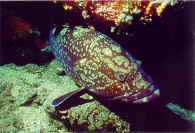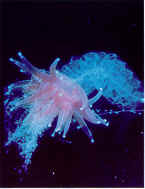|



|
The
uncontaminated navy reserve of "Isola dei Ciclopi”
offers splendid depths for the underwater immersions.
There are many centres of immersion that manage this activity
from years, allowing also to the amateurs to admire Acitrezza's marine
beauties.
We can find lava depths until to approximately 30 metres, then
are sandy and, beyond 50/60 metres mostly become argillaceous,
sometimes, there are presences of circular lava blocks. Marine flora and
fauna, especially up to 30/35 metres of depth, give the possibilities of numerous
underwater routes suitable for the underwater photographies. You can
see various kind of green seaweeds like Cystoseria or Sargasso. The grasslands
of Posidonia, instead, particularly are situated between Lachea island and the coast. Beyond the 35
metres of
depth and until approximately 50/60 metres there are calcareous red
and violet seaweeds (Melobesie). Equally interesting is the rich fauna of vertebrated and invertebrated
living the
depths of Acitrezza. About fishes, we can find groupers, conger eel and moray nest inside
the gorges or admiring lots of young
“monacelle” that will become brown. Other species most
common are: anchovy and various fish of depth
living in green seaweeds and posidonie like serrani, girelle, labridi,
sargos, ope, salpas and many others. Among the most important
crustaceans are common the hermit crab, the crab and more depthly, in
front of the “Lachea”, the lobsters. It is an enjoyness for the
photographers superficial walls colonized to hundred of yellow or
rose corals or small grassland of fluctuating white “idrozoi” by
the undulatory movements. In the small channels of the Cyclopean
rocks there are yellow and red
“gorgonie”, sponges and colonies of red “briozoi” of
Miryozoum (false coral) and the most delicate rose “trine” of the Retepore islands. The depths of Acitrezza are famous
for their molluscs: from delicious and appreciated “occhi di
bue” (Haliotis), to imposing Fins, to the rare and precious
for the collectors shells of “Mitra zonata” and
“Coralliophila sofiae”.

|